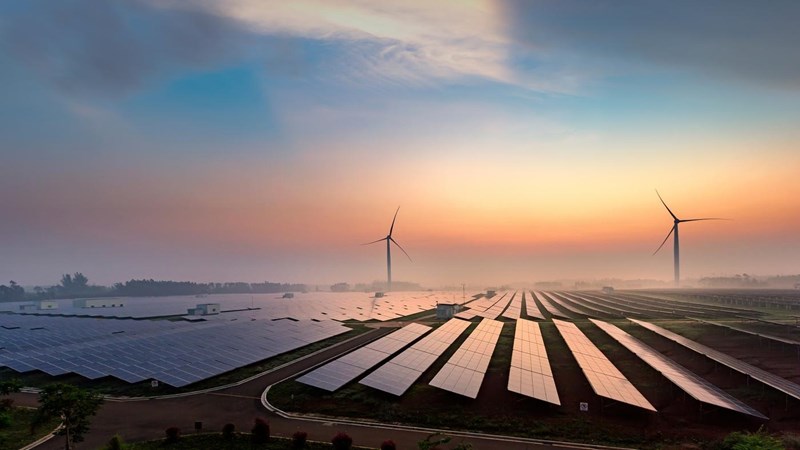Energy transition glossary
This glossary provides definitions and explanations for key terms and concepts related to the global shift from fossil fuels to renewable energy sources. Bookmark this page to stay updated as the energy landscape evolves.
Decoding the energy transition
Whether you're an industry professional or new to the field, our energy transition glossary will help you understand the key terms and keep up with the latest developments in the field. Understanding what the transition entails is important for anyone interested in the future of energy. This resource has been designed to help you navigate through energy transition definitions and jargon.

Glossary of terms
Organised alphabetically into four sections, for easy reference to key energy industry terms.
Advantaged oil
Oil reserves with the lowest production costs and carbon emissions and the best economics, making them the most favourable for investment and development.
Learn more: Scraping the barrel: Is the world running out of high-quality oil and gas?
AI (artificial intelligence)
Technology that mimics human intelligence to carry out actions such as problem-solving and decision-making. AI could be a boon for the energy industry by raising demand, driving efficiencies, enabling low-carbon technologies and even addressing climate change.
Learn more: Artificial intelligence and the future of energy.
BESS (battery energy storage systems)
Devices that store and distribute electricity, providing fast, long-lasting and responsive adjustments to changing grid conditions.
Learn more: Underwriting Battery Energy Storage Systems (BESS) as an asset class.
BOE (barrel of oil equivalent)
A standardised measure that quantifies the amount of energy that is equivalent to the energy content of one barrel of oil. This allows comparison across different energy sources.
Biomass
Renewable energy source, drawn from organic matter, such as wood, crops and human/animal waste.
Find out about the potential: Bioenergy: a US$500 billion market opportunity.
Carbon intensity
The amount of carbon dioxide (CO2) emissions produced per unit of activity, output or consumption. Typically, renewable energy sources have a lower carbon intensity than fossil fuels.
Try our Emissions Benchmarking Tool to assess and improve your organisation’s carbon intensity.
Carbon markets
Carbon markets facilitate the buying and selling of emission allowances or credits, providing an economic incentive to reduce greenhouse gas emissions globally and encouraging investment into clean technologies. See also ‘Carbon offsets’.
Learn more: Voluntary carbon markets: here to stay?
Carbon neutral
Where the total amount of carbon dioxide emissions produced by an organisation or activity is offset by an equivalent amount of carbon dioxide removal.
Find out how companies are disclosing carbon offsets: The big moment for carbon accounting or try our Lens Carbon tool.
Carbon offsets
Credits that are traded on carbon markets. Carbon offsets are generated by two kinds of projects – those that reduce or avoid emissions and those that remove and store legacy CO2 from the atmosphere.
Find out more: Carbon offsets: key considerations for corporates.
Carbon policy
The collective strategies and measures implemented by governments and organisations to address carbon dioxide emissions, foster the transition to renewable energy sources and mitigate the effects of climate change.
Explore some recent policy developments: 2024’s carbon policy so far: four key takeaways.
Carbon taxes
A financial mechanism put into effect by governments that imposes a fee on the carbon content of fossil fuels, based on the amount of carbon dioxide emitted when they are burned.
Read our take on how emission taxes on imports could transform the global LNG market in Call of Duties.
CBAM (carbon border adjustment mechanism)
The EU CBAM seeks to address the issue of carbon leakage by ensuring equivalent carbon pricing for imports and domestic products. Launched in October 2023, with full implementation to be in effect by 2034, it was the first mechanism of its kind in the world.
Explore the significance: Playing by new rules: how the CBAM will change the world.
CCUS (carbon capture, utilisation and storage)
Technologies that remove CO2 from the atmosphere or trap CO2 emissions from industries, like power plants and refineries, and either store it underground or repurpose it for commercial use.
Dive deeper: Carbon capture, utilisation & storage: what you need to know.
Circular economy
A system where materials and products are kept in circulation through maintenance, reuse and/or recycling, and waste and pollution are minimised.
Explore the waste to wealth opportunity.
Critical minerals
Elements or compounds that play essential roles in strategically important sectors. This includes crucial energy transition metals, such as lithium, cobalt, graphite, nickel and copper. Criteria varys by country, but supply chain vulnerabilities are a common concern.
Learn more: The energy transition needs minerals: is deep sea mining the best way to get them?
DAC (direct air capture)
DAC is an umbrella term for technologies that to capture carbon dioxide from ambient air for storage or reuse.
Read more: Low-carbon tech: can direct air capture rise to the challenge?
Decarbonisation
Reducing or removing carbon dioxide emissions from processes including energy production and manufacturing to mitigate climate change.
Learn more: Google’s demanding goals for decarbonisation.
DERs (distributed energy resources)
DERs are smaller-scale energy resources, such as solar panels and wind turbines, that contribute electricity directly to facilities or communities. They reduce dependency on the grid by providing decentralised energy solutions that can operate independently or feed energy back into the main grid.
Read more: Tiny drops create mighty oceans: how distributed solar keeps the Puerto Rico grid afloat.
E-fuels
E-fuels, also known as electro fuels or synthetic fuels, are synthetic alternatives to fossil fuels produced by combining green hydrogen with captured carbon or nitrogen.
Learn more: Adding fire to e-fuels: Are synthetic fuels the key to unlocking growth in hydrogen?
Electrolysis
Using electricity to split water into hydrogen and oxygen within an electrolyser. When fuelled by renewable power, this produces green hydrogen with the potential for near-zero emissions.
Energy intensity
Refers to the amount of energy required to perform a specific task or produce a unit of output in a system or process. Lower energy intensity indicates higher efficiency.
Energy transition
The global shift away from fossil fuels and towards the use of cleaner, renewable energy sources, like wind and solar.
Learn more: Energy transition outlook.
ESG (environmental, social and governance)
Evaluates the environmental and societal impact of a company or organisation, as well as the accuracy and transparency of its governance. ESG metrics can affect investment decisions.
Explore further: Beyond ESG: measuring corporate sustainability in an uncertain world.
ETO (energy transition outlook)
Wood Mackenzie’s ETO maps three different routes through the energy transition with increasing levels of ambition – but also difficulty and investment.
Check out our ETO scenarios.
Energy storage
The capture of energy produced at one time for use later, helping to balance energy demand and production. A device that stores energy is generally called an accumulator or battery.
Read more: Global energy storage: five trends to look for in 2024.
FID (final investment decision)
The critical point where a company decides whether to fully commit to an energy project, involving significant financial commitments and contract signings.
Read our predictions for upstream FIDs in 2024.
Floating solar/floating photovoltaics (FPV)
Solar panels mounted on structures that float on bodies of water. This helps to address issues like limited land availability and increasing land costs.
Read more: Global floating solar to top 6GW threshold by 2031.
Floating wind
Offshore wind turbines mounted on floating structures, allowing them to generate electricity in deeper, more remote waters with higher wind potential.
Fossil fuels
Non-renewable energy sources, including coal, oil and gas, formed in the geological past from the remains of living organisms. The energy transition is the transformational switch away from fossil fuels and into renewable resources.
Dive into the debate on phasing out fossil fuels: COP28: Will COP28 deliver a pledge to phase out fossil fuels?
FPSO (floating production storage and offloading)
A large vessel used by the offshore industry for the production, processing and storage of oil and gas.
Explore our upstream oil and gas research.
Geothermal energy
A renewable source of heat from below the Earth’s surface. It has traditionally only been economic in regions where an abnormally hot subsurface is combined with permeability. New technology could change that.
Learn more: Geothermal energy: the hottest low-carbon solution?
GHG (greenhouse gases)
Gases in the atmosphere that trap heat, contributing to the greenhouse effect and global warming. Major GHGs include carbon dioxide, methane and nitrous oxide.
Learn more: Carbon management frequently asked questions part 1: emissions.
Grid edge
An umbrella term that covers the distributed hardware, software and innovations that exist in proximity to the end user, away from centralised generation. This includes EV charging infrastructure, behind-the-meter (BTM) resources and heat pumps.
Read more: The grid edge: what you need to know.
Hydrocarbons
Compounds of hydrogen and carbon, found in crude oil and natural gas. See also 'fossil fuels'.
Hydrogen
Hydrogen has huge potential as a fuel to support a net zero future and can offer a cleaner alternative to fossil fuels. There are different types of hydrogen, defined by production methods.
Green hydrogen is produced using renewable energy and electrolysis and offers the potential for near-zero emissions.
Blue hydrogen is mainly produced from natural gas, using carbon capture and storage to reduce emissions.
Black hydrogen is created by using black, bituminous coal as the primary feedstock and results in high carbon emissions.
Brown hydrogen is made from lignite (brown coal) and also results in significant CO2 emissions.
Yellow hydrogen is produced by electrolysis, fuelled by solar power.
Pink hydrogen is generated through electrolysis powered by nuclear energy.
White or gold hydrogen is naturally-occurring, geological hydrogen found in underground deposits, often through fracking.
Is it time to get over the hydrogen rainbow?
ICE (Internal combustion engine)
A vehicle powered by conventional, oil-derived fuels such as petrol/gasoline or diesel. These kinds of vehicles burn fuel within the engine to generate power, producing emissions.
Read our latest EV insights.
Intermittent generation
Renewable energy technologies are described as intermittent as they can’t always provide continuous generation 24 hours a day. Wind turbines, for example, can’t generate if there is no wind. Conversely, they could face shutdowns if wind speeds are too high.
Read more: How to address risk from the intermittency of renewable energy in power markets.
IRA (Inflation Reduction Act)
Flagship US policy signed into law by President Biden in 2022. The bill offered hundreds of billions for clean energy and decarbonisation measures through grants, loans, tax credits, and other incentives.
One year on, we explored the impact of the IRA.
Just transition
A concept that seeks to ensure the benefits of energy transition are shared widely, while supporting those who might be economically impacted by the shift.
Find out more: Winners and losers in the energy transition.
LCOE (levelised cost of electricity)
A measure of the average net present cost of electricity generation for a generator, enabling comparison between different technologies.
Try out Lens Power to explore LCOE for markets and technologies.
LFP battery
A type of lithium-ion battery, using lithium iron phosphate as the cathode material, often used in EVs and energy storage.
Learn more: Demand for batteries is skyrocketing: we need new ways of extracting lithium.
LCA (life cycle assessment)
'Cradle-to-grave' analysis of the overall environmental impact of a product or service, from raw materials through to production and use, to final disposal.
Our Emissions Benchmarking Tool provides lifecycle analysis of GHG emissions, looking at Scope 1, 2 and 3.
Li-ion (lithium-ion) battery
A type of high capacity, high power, rechargeable battery that was commercialised in the 1990s and quickly became the technology of choice for EVs and energy storage systems.
Find out more: Batteries: frequently asked questions.
LNG (liquefied natural gas)
Natural gas that has been cooled to a liquid state for safe and efficient shipping and storage.
Get a demo of Lens Gas & LNG.
Materials transition
The process through which we account for and minimise the environmental costs associated with the extraction, use and disposal of raw materials consumed in the global economy.
Welcome to the materials transition.
Na-ion (sodium-ion) batteries
A type of rechargeable battery technology that uses sodium ions as charge carriers. Na-ion batteries are being explored as an alternative to li-ion as they use fewer, or even no, critical minerals. However, na-ion batteries are heavier and larger than Li-ion.
Batteries: frequently asked questions.
Net zero
The target to balance the amount of greenhouse gases produced with the amount removed from the atmosphere. This requires both emissions reduction and mitigation strategies.
Explore our net zero by 2050 scenario.
Offshore wind
The generation of electricity through wind farms located at sea, where higher wind speeds can allow for increased generation compared to onshore wind farms.
Cross currents: charting a sustainable course for offshore wind.
Onshore wind
Wind turbines located on land, that harness the natural movement of air to generate low-carbon power.
Find out more about the growth of wind: Record highs for global wind turbine order intake in 2023.
Paris Agreement
A pivotal accord, adopted at the COP21 conference in Paris, that aims to limit the increase of the global temperature to well below 2°C with an additional effort to limit the increase to 1.5°C.
Is the world on track? Read our reflections on COP28.
Peak oil
The theoretical timeline for when domestic or global oil production will hit its maximum rate and begin to decline. In our energy transition outlook, peak oil demand doesn’t happen until 2030 (peak gas demand follows a decade later).
Learn more: Will oil, gas and coal peak by 2030?.
PV (photovoltaics)
Solar panels, also known as photovoltaics (PV) convert sunlight into electricity. This renewable power source provides a sustainable alternative to traditional fossil fuels.
Read more: Global solar PV installed capacity will more than triple in the next ten years.
PPA (power purchase agreement)
A long-term contract between an electricity producer and a customer, typically a utility, government or company, setting a pre-negotiated price for energy over a set period.
Learn more: The ever-changing role of PPAs in the energy transition.
Rare earths
A group of 175 elements ranging from lanthanum to lutetium in the periodic table. New energy technologies, specifically wind turbines and EV drivetrains, have spurred demand for rare earth permanent magnets.
Rare earth elements: frequently asked questions.
RECs (renewable energy certificates)
Tradable certificates representing proof that one megawatt hour (MWh) of electricity was generated from a renewable source and fed into the grid.
Explore our power market research.
RNG (renewable natural gas)
Also known as biomethane, RNG is upgraded from biogas, mostly produced through anaerobic digestion of organic matter such as agricultural and food waste. It is fully interchangeable with conventional natural gas and can have up to five times lower carbon intensity.
Our Biomethane/RNG Service provides in-depth insight into the market.
Scope 1, 2 and 3
Scope 1 encompasses direct emissions from sources owned or controlled by a company., Scope 2 includes indirect emissions from electricity supply to operations. Scope 3 covers all other indirect emissions in the supply or services chain.
Our Emissions Benchmarking Tool provides lifecycle analysis.
SMR (small modular reactor)
Advanced nuclear reactors with a power capacity of up to 300 MW(e) per unit, designed with modular technology that can be built in stages as demand expands.
Learn more: Nuclear’s massive net zero growth opportunity.
Sodium-ion (Na-ion) batteries
Rechargeable batteries that use sodium ions to store and discharge energy. Na-ion is being explored as a potential alternative to lithium-ion (li-ion) batteries due to their lower-cost raw materials.
Batteries: frequently asked questions.
SAF (sustainable aviation fuel)
Rather than being refined from petroleum, SAF is produced from sustainable biological and waste sources, and therefore achieves significantly lower lifecycle emissions than conventional jet fuel.
Find out about a groundbreaking new method of sustainable aviation fuel production.
Transmission
The large-scale movement of high-voltage electricity from power plants and generators to substations, where it can be distributed for use.
There’s no transition without transmission. How can we make it easier to build?
Upstream oil & gas
Upstream relates to the exploration and production of oil and gas. Midstream refers to their transportation and storage, prior to refining. In the downstream phase, crude oil is refined and distributed as finished products.
Read our latest oil and gas insights.
WtE (waste-to-energy)
The conversion of non-recyclable waste into usable energy, such as electricity and heat.
Read more: Could energy recovery solve the mounting problem of global waste?





